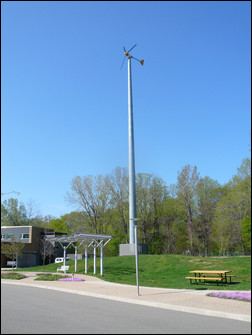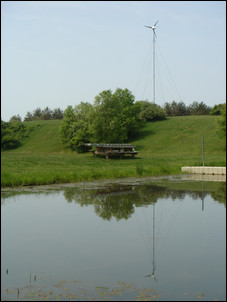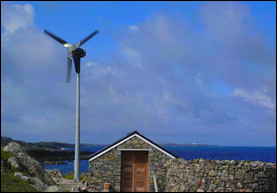If you want energy that is clean, reliable and, after the initial investment, free, consider adding a wind turbine to your landscape.
Wind turbines work by harnessing the power of wind to create electricity. This method of making energy is considered “clean” because—unlike coal or other energy generators—wind energy does not produce greenhouse gases. But unlike solar energy, which is available to anyone with a roof, wind energy requires something not everyone has: space.
 The Bergey Windpower Excel Wind Turbine is 22 feet in diameter and supplies 10 kilowatts of energy, enough to power the average home. |
“Our main customers are homeowners that have an acre of property or more and electric bills of at least $150 per month and live in one of the handful of states that offer a robust rebate,” says Mike Bergey, president of Bergey Wind Power Company in Norman, Okla. “In those places, you can recoup your investment in five to 10 years.”
State rebates help shoulder a turbine’s price tag, which ranges from $12,000 to $60,000. In New York, for example, incentives range from $2,400 to $120,000 depending on the size of the turbine you erect. Other states with favorable incentive programs include California, Oregon, New York, Massachusetts, New Jersey, Vermont, Ohio and Illinois. To learn more about the programs available in your state, visit the Database of State Incentives for Renewables and Efficiency. Currently, there is no federal tax incentive for wind power as there is with solar power, but bills proposing such a program are being considered by Congress.
 Windward Engineering’s Endurance turbine, which can be used on any property half-acre or larger, is specifically designed to bring wind power to the masses. |
Turbines aren’t cheap, but with the money you’ll save on your electric bills they pay for themselves over their minimum-30-year lifetime, says Bergey. Calculating how long it will take you to recoup your investment is complicated and individualized depending on your average energy use, wind speeds in your area, the height and size of your turbine, and your state’s tax incentives. The American Wind Energy Association Small Wind Toolbox can provide some pointers on determining whether wind energy is a feasible financial investment.
But before you do the math, it’s important to understand exactly how these units make electricity.
How Turbines Work
Wind is one of the Earth’s most basic energy sources. Think of a sailboat skimming across the water. All that motion is made possible purely by wind energy. That same power can also be used to fuel your furnace and turn on your lights.
The turbine itself consists of a rotor with two or three blades, a generator mounted on a frame and a tail to keep the turbine facing into the wind. The larger the diameter of the rotor, the more energy the turbine produces. The kinetic energy in the wind turns the turbine blades, generating mechanical energy. A generator attached to the turbine then converts that power into electricity. Most turbines have security systems that stop the rotor from spinning if winds become too strong.
The taller your turbine, the more power it will produce because wind speeds increase with distance from the ground. A 100-foot-tall tower is going to produce 25 percent more power than a 60-foot tall one, according to the Department of Energy. Most turbines range from 80 to 140 feet in height, Bergey says.
“Higher is better in almost every single case,” says Ron Stimmel, small wind advocate for the American Wind Energy Association (AWEA). “You get above the tree line and house line and the wind can really stretch its legs. Even small increases in wind speed mean exponentially more power. So it is always worth it to get the tallest towers you can.”
Contrary to popular belief, turbines are not unbearably loud. “They’re about as loud as a refrigerator,” Stimmel says. “The sound they make is usually masked by the sound of the wind itself.”
 The Proven Energy 2.5-kilowatt turbine stands up to 36 feet tall and reaches 11 feet in diameter. This model can power a three-bedroom home, excluding the heating system. |
Homeowner Considerations
The only DIY part of a turbine installation is finding and hiring the right wind power company. Which company you choose will depend on your geographic location, the size of turbine you want and pricing. A list of commercially proven providers can be found on the AWEA Web site.
Finding an unobstructed locale for your turbine will help you harness the most energy. “If you are in a mountainous area and your property is down at the bottom of a very steep sided valley, it is probably not a good place for a wind turbine,” says Paul Gipe, author of Wind Power: Renewable Energy for Home, Farm and Business. “But if your property is on top of a ridge or on a wind swept great plain or in a cornfield in the Midwest, yes, then—it might make sense.”
The Wind Powering America Wind Resources Web site can help you determine whether your area has the recommended 9 miles per hour minimum wind speed.
How big a turbine you need depends on how much energy you use, but most one-family homes require a 5- to 15-kilowatt unit. Most homeowners with a single turbine will want to remain “on the grid” and have municipal electricity as a backup source. This is because in most parts of the country, wind speeds decrease in the summertime, and having a backup power source reduces the risks of brownouts and blackouts. To be completely off-grid, you’ll need to eschew central air and electric heat, which are the home’s two biggest energy guzzlers.
Going completely “off grid” is possible with wind energy. But keep in mind that wind systems generally generate less electricity during the hot summer months, meaning you’d have to have a backup system to maintain power to your home. Backup batteries can store wind energy, but most banks can save three days worth of energy at most. Diesel-powered generators are another option.
You can purchase a single turbine for personal use or, if you own large acreage such as a farm or ranch, you can put up several turbines and create a wind farm. Some local electricity companies will pay to lease farmland for turbines, making this a possible source of income if you have enough land. Even if you only have a single turbine, you might be able to sell unused energy back to your local utility company. Programs vary by provider, so contact your local electric company to find out more about these plans.
Considering all these factors—environmental, cost-saving and even profit-making—expect to see more and more turbines dotting the landscapes in years to come. The number of units grew 14 percent in 2007, according to the AWEA. That group is lobbying, along with turbine manufacturers, for a federal tax credit similar to that afforded to solar systems. And if it passes, experts say you can expect to see more and more turbines dotting the landscape.
Credit: Renovate Your World




























